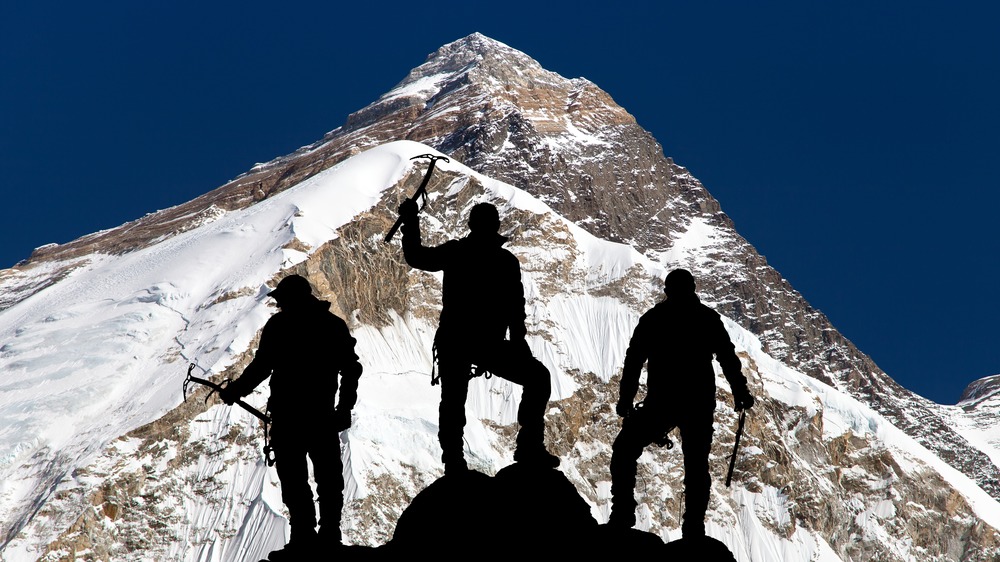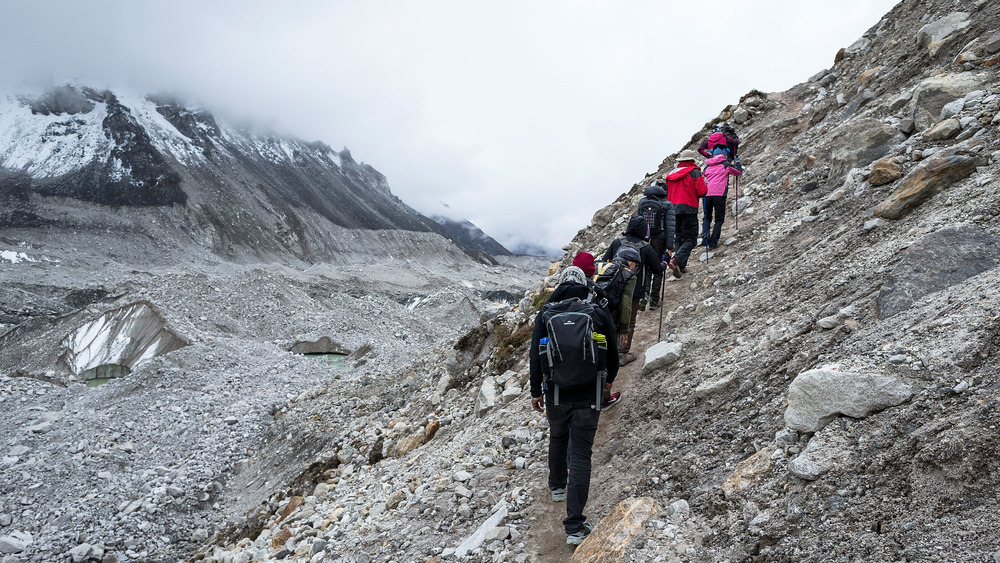The Serious Problem Of Poop On Mt. Everest
Just about 28,000 pounds. That's how much human waste (and let's not be coy, we're talking poop here) was removed from the world's tallest mountain after its 2018 climbing season. And it's a much more serious problem than just a simple issue of courtesy. Each short climbing season (roughly April into May) sees hundreds of climbers attempting to summit Mt. Everest. According to the University of Washington, around 500 tried in 2020. It may not sound like that many climbers, but look at it like this: think about the number of trips you've taken to the bathroom in the last few months. More than you can possibly recall, right?
We won't ask you to do the math because thankfully, the Washington Post already has; an average climber will produce 60 pounds of excrement in a typical climbing season. Now multiply that by 500 climbers and you can start to appreciate the scope of the problem. So how did one of the seven natural wonders of the world end up a poop-covered mess? Turns out the answer is a little more complex than just carelessness.
Let's first look at the problem from a relatable perspective; how do you, you know, go on Mt. Everest? Well, much like climbing the mountain, it's pretty easy early on. Since climbers must spend time getting acclimated to the harsh environment and lack of oxygen, they often spend days or weeks at base camps, where poop is collected in drums.
A problem rolls downhill
These drums (or other gear, like portable toilets) should be removed by whatever expedition group the climbers have hired to guide them. Emphasis on "should." According to Global News, "Budget expedition companies charge as little as $30,000 per climber, cutting costs including waste removal." Climbers hoping to take a more natural approach to their waste elimination may opt to drop trou over a crevasse, though even this doesn't help matters. Thanks to rising temperatures that melt the mountain's ice and snow pack, even those crevasses are disappearing. As Global News goes on to explain, the squat option causes even more problems when excess waste travels, as one might imagine on a mountain, downhill. It can get into the water supply that climbers at Base Camp rely on, or endanger those living in towns downstream.
Despite the fact that the mountain has arguably become, as Grayson Shaffer colorfully put it in a 2014 Washington Post opinion piece, a "fecal time bomb," there's more to Everest's woes than waste alone.
Everest's problems are bigger than poop
With hundreds of climbers attempting to summit each year, you might expect a lot of garbage to be left behind, and you'd be right — to the tune of more than 24,000 pounds worth. That's how much trash one cleanup effort carried off the mountain after the 2019 season, according to the Washington Post, which went on to allege that some call Everest the "world's highest garbage dump."
All the standard modern detritus of humans can be found on Everest, including tents and equipment that panicked or strained climbers ditch on the way up once it becomes too heavy, plus bottles, cans, batteries and more. It's not only a blight on the mountain, it's also a spiritual hardship for the region's ethnic Sherpas, the mountain guides who consider Mt. Everest sacred.
All the standard modern detritus of humans can be found on Everest, including, as the BBC reports, tents and equipment that panicked or strained climbers ditch on the way up once it becomes too heavy, plus bottles, cans, batteries, and more, as the Washington Post tells us.
Looking for solutions
It's not only a blight on the mountain; per the Daily Beast, it's also a spiritual hardship for the region's ethnic Sherpas, the mountain guides who consider Mt. Everest sacred.
All of these competing interests put the government of Nepal, home to Mt. Everest, in a difficult position. Limiting permits that might mean fewer climbers and less waste would also cut into the $300 million the expeditions bring into the country, per The Los Angeles Times. As for the poop problem, a solution may be on the horizon.
Since 2010, a team co-led by engineer Garry Porter, as the Mount Everest Biogas Project explains, has been hard at work on what they call an "Anaerobic biogas digester system." In other words, a device that uses microorganisms to break down the waste, the end products of which would be methane gas or fertilizer. As Porter put it in an interview with CNN, "[The project] takes a nasty product and makes two products that can be used by the Nepali people." Though still in development, the system looks promising. Meanwhile, in just a few months, another climbing season will begin on Mt. Everest. After that, as always, comes the cleanup.



